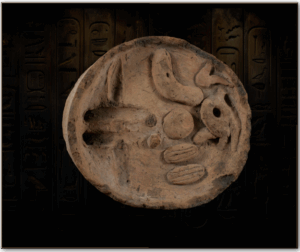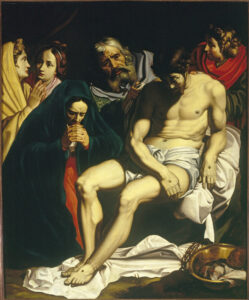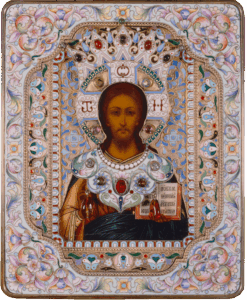In this lovely painting, Ambrosius Benson captures the innovative spirit of the Renaissance and Reformation painters.
Category Archives: M&G Collection Online
Lamentation over the Dead Christ
Oil on panel, c. 1610–12
Abraham Janssens
Flemish, c. 1575–1632
When the word “baroque” is mentioned, there are two names that people associate with this art history movement—Italian artist Michelangelo Merisi da Caravaggio and Flemish artist Peter Paul Rubens. Both artists dominated Europe with their dramatic scenes, rich colors, chiaroscuro, accomplishments, and larger-than-life personalities. In the shadow of these masters and their artistic masterpieces, other artists have done their best to imitate or infuse their own style with these titans’ techniques. One such artist is fellow countryman to Rubens, Abraham Janssens.
Janssens’s work had impressive range. Throughout his career, his subject matter included biblical, historical, and allegorical scenes as well as occasional portraits. His stylistic changes are perhaps the most interesting. The first paintings of his oeuvre would be labeled Flemish Mannerist. Then after a trip to Italy in the early 1600s, he began to adopt a more Caravaggesque approach. Finally, his work became more Rubenesque after Rubens returned home and began to command the Flemish art scene. Janssens’s shift in his different styles can be seen in one specific subject matter—the Lamentation of Christ.
The Lamentation of Christ is an extra-biblical subject that portrayed groups of people mourning around the dead Christ. As mentioned in the gospels (Matthew 27:59-61, Mark 15:46-47, Luke 23:53-56, and John 19:38-42), this group usually included His mother, Mary, and various others. It is the perfect subject matter to compare Janssens’s stylistic shift since it shows strong emotion, sculptural figures, and a dramatic biblical narrative.
First, is Janssens’s Lamentation of Christ painted between 1600 and 1604. This work shows typical Mannerist characteristics with its bright colors and elongated figures. There is emotion, but it is not the intense drama of the Baroque. Since Janssens was in Rome from 1598-1601, it is interesting to note that he did not immediately adopt Caravaggio’s style. According to 17th-century Dutch painting scholar, Justus Müller Hofstede, most of Caravaggio’s early innovations in Italian painting (ca. 1593-1598) such as half-figure compositions, still-life painting, and secularization of religious themes were already in use in Antwerp. Hofstede concludes that Caravaggio’s early pioneer work wouldn’t have impressed Janssens.
It wasn’t until 1607 that Janssens began incorporating Caravaggio’s technique. This style is wonderfully shown in the Museum & Gallery’s Lamentation Over the Dead Christ, painted between 1610-1612. There is a marked stylistic shift to baroque characteristics compared to the first Lamentation. There is a sculptural, monumental quality to his figures, which would become a trademark of Janssen’s career. The lighting is harsh and dramatic and reminiscent of Caravaggio’s best works. This Lamentation also shows an extreme depth of sorrow. The furrowed, anguished brow on Mary is a contrast to the first Lamentation’s rather passive Mary.
Finally, Janssens began adapting to a Rubenesque approach. His later The Lamentation over the Dead Christ painted in 1621-22 includes similar elements from M&G’s Caravaggesque example. However, it does not have the same harshness or extreme sorrow. You can see Rubens’s influence in the rich coloring and more dramatic movement throughout the composition. Janssens still maintains his trademark stiffness and sculptural feel to his figures. According to historian Irene Schaudies, it is Janssens’s focus on his figures looking like classical statues rather than painting from empirical observation like Caravaggio and Rubens that kept Janssens in their shadow. Nevertheless, by looking at these three paintings, one can appreciate what a master Janssens was with his different stylistic portrayals of one of the most emotive scenes in Scripture.
KC Christmas Beach, M&G summer art educator
Published 2025
Orazio de’ Ferrari skillfully captures one of the Old Testament’s most powerful stories.
Procession to Calvary
Oil on Panel
Otto van Veen
Flemish, c. 1556–d. 1629
Otto van Veen was a classically trained humanist artist or pictor doctus, a concept created by the ancient writer Horace in his Ars Poetica signifying the attempt by artists to regain the social standing of the ancients. Otto van Veen succeeded. A renowned court painter to several rulers, he led the Antwerp art scene, diminishing only when his pupil Peter Paul Rubens returned from his travels in 1608. He paid tribute to Horace by creating two series of emblematic art which coupled Horatian proverbs with an illustrative image. A Romanist painter, he continued the traditions of the church through his work, including this one in M&G’s collection.
Using the usual cast of characters—Roman soldiers, weeping women, Simon of Cyrene, and a jeering mob—van Veen pictures the procession to Calvary just outside the city gate. A woman in the foreground holds up a piece of cloth to Christ who has stumbled under the cross and brought the procession to a momentary halt. St. Veronica offers her veil to Christ to wipe his brow. Traditionally, He accepts her kindness and a likeness of His face appears on the veil when it is returned to her. Scholars debate whether the woman is named Veronica or that the replication of Christ’s “true image”—vera icon—contributed to her name. She is part of a trio of women; the others have children with them, which reminds the viewer that Christ welcomed little children to come to Him. Just slightly behind these women are Mary with clasped hands in her usual blue robe and John, already attentive to her wellbeing.
Van Veen visually divides the scene with the positioning of the cross. On one side is the sympathetic crowd; on the other is the iron hand of Rome. The right side of the panel draws the viewer’s eye to the white horse ridden by a Roman soldier and the muscular figure pulling Christ up the hill with a rope. The dress of this man and the man behind the cross who whips Simon and Christ indicates that they are not part of the military structure of Rome. Instead, they seem to be commoners employed by Rome for the occasion. Combining this fact with the intense, backward gaze of the prominent soldier on horseback creates a personal interaction between the viewer and the scene. The sinfulness of every man compels an atonement be made for a restoration of relationship with God. In the foreground, the open area at this stopping point on the way to Golgotha provides room for the viewer to be included in the picture’s events and to consider which “side” of the scene he will be part of: sympathetic or condemnatory.
Dr. Karen Rowe Jones, M&G board member
Published 2025
Additional Resources:
For additional information on an etching by N. Muxel made after Otto van Veen’s Procession click here.
To see an image of Otto van Veen’s Christ Meeting St. Veronica from the Royal Museums of Fine Arts of Belgium click here.
Luca Giordano, a child prodigy, would become one of the Baroque era’s most noted Neapolitan artist. M&G has at least three of his works including The Triumph of Miriam.
Flemish artist Pieter Jan van Reysschoot masterfully illustrates Christ’s use of creation to teach the multitudes about God’s compassionate character.
Monthly Update
Sign up here to receive M&G’s monthly update and collection news!
EXPLORE More Online Features
Speakers Bureau
We can speak for your retirement group, civic club, church fellowship, or book club. Contact us here or at 864-770-1331.
Support Our Work
Make a Gift to M&G to help our current work and future plans.





